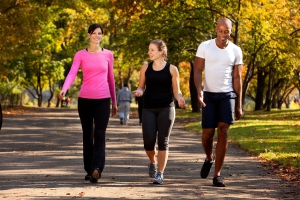Walking is one of the easiest, cheapest and most enjoyable forms of exercise around. We all need to do a balance of “cardio” exercise as well as strength and flexibility exercise such as Pilates. I reccomend walking as a fun, effective way of fitting in some cardio.
As seasoned walkers will know, walking is so much more than just an activity to keep us fit. It has many health benefits, most which can be achieved from as little as 20 minutes of brisk walking each day. Here are some of the best reasons why walking is good for your health.
1. Cardiovascular and Respiratory Health Benefits
Walking strengthens your heart, lungs and blood vessels, known as your cardiorespiratory system. As your CR system becomes stronger your lungs are able to inhale and exhale more air with each breath. Your heart also becomes stronger and able to pump more blood around your body with each beat. These adaptions mean more oxygen to be circulated to your working muscles per minute, for increased energy production and movement. Waste products from energy production can be removed faster too, to prevent muscles tiring and cramping when you “push yourself” to walk faster or longer.
This explains why regular walkers can walk faster and for longer without becoming out of breath – as they have stronger CR systems. Long term walkers also benefit from lower resting heart rates, lower resting blood pressures and lower cholesterol levels.
2. Mental Health Benefits
Nothing boosts your mood and clears your mind quite as much as brisk stroll in the great outdoors. Walking allows you to focus on your surroundings and your physical movements, drawing your attention away from the hassles of everyday life. Focusing on our physical feelings, passing thoughts and natural surroundings are aspects shared with the art of mindfulness, which is known for its mental health benefits. Social walkers can feel happier and better about themselves after a laugh, and chat on a walk with friends and dog walkers can enjoy similar benefits from spending time with their favourite pooch.
3. Healthy Bones
Walking is a weight bearing exercise which can help to prevent osteoporosis for those with or at risk of developing the disease. Osteoporosis is a thinning of the bones which can occur with aging and women are more at risk of getting it than men.
Regular weight bearing exercise such as brisk walking can improve bone density to prevent or improve Osteoporosis. Walking also improves muscle strength, balance, posture and co-ordination and is low risk, to prevent falls and fractures. Brisk walking is recommended by the National Osteoporosis Society as it is a safe and effective exercise to strengthen the bones. (More info at https://nos.org.uk/information/healthy-living-and-risk/osteoporosis-exercises/)
4. Healthy Joints
Walking improves the strength and mobility of your joints, predominantly hips, knees and ankles. Walking reduces joint stiffness, as it warms the muscles supporting the joints and increases synovial fluid production within the joints, which acts as natural lubrication for smooth movement. An appropriate warm up and cool down, with simple stretches and a gradual increase or decrease of walking pace is also advisable to maximise the mobility benefits of walking.
Regular walking also improves the health of the tendons, ligaments and muscles supporting the joints, improving joint range of movement. Walking is a low impact form of exercise as it does not involve running, jumping or high levels of force production. This makes it a more comfortable and enjoyable exercise for people with joint issues such as arthritis, bursitis or cartilage injuries.
5. Long term Health Benefits
Walking can help you to keep your weight under control, maintaining a healthy weight is important for feeling your best mentally and physically. As mentioned earlier walking is good for your heart and lungs, the Stroke Association advise a brisk 30-minute each day to prevent and reduce high blood pressure (which can lead to a stroke).
Walking can help to reduce and control blood sugar levels for those with type two diabetes, or pre-diabetes syndrome, as working muscles use these circulating sugars for energy production and movement. Regular walking can reduce the risk of getting cancer and the cancer charity MacMillan actively promote walking to help people reduce their risk of cancer, or to live well with the disease (read more at http://www.macmillan.org.uk/information-and-support/coping/maintaining-a-healthy-lifestyle/keeping-active/health-walks.html)
There you have it – the best reasons to get your boots on and go for a walk in the fresh air – I think that’s what im about to do!



